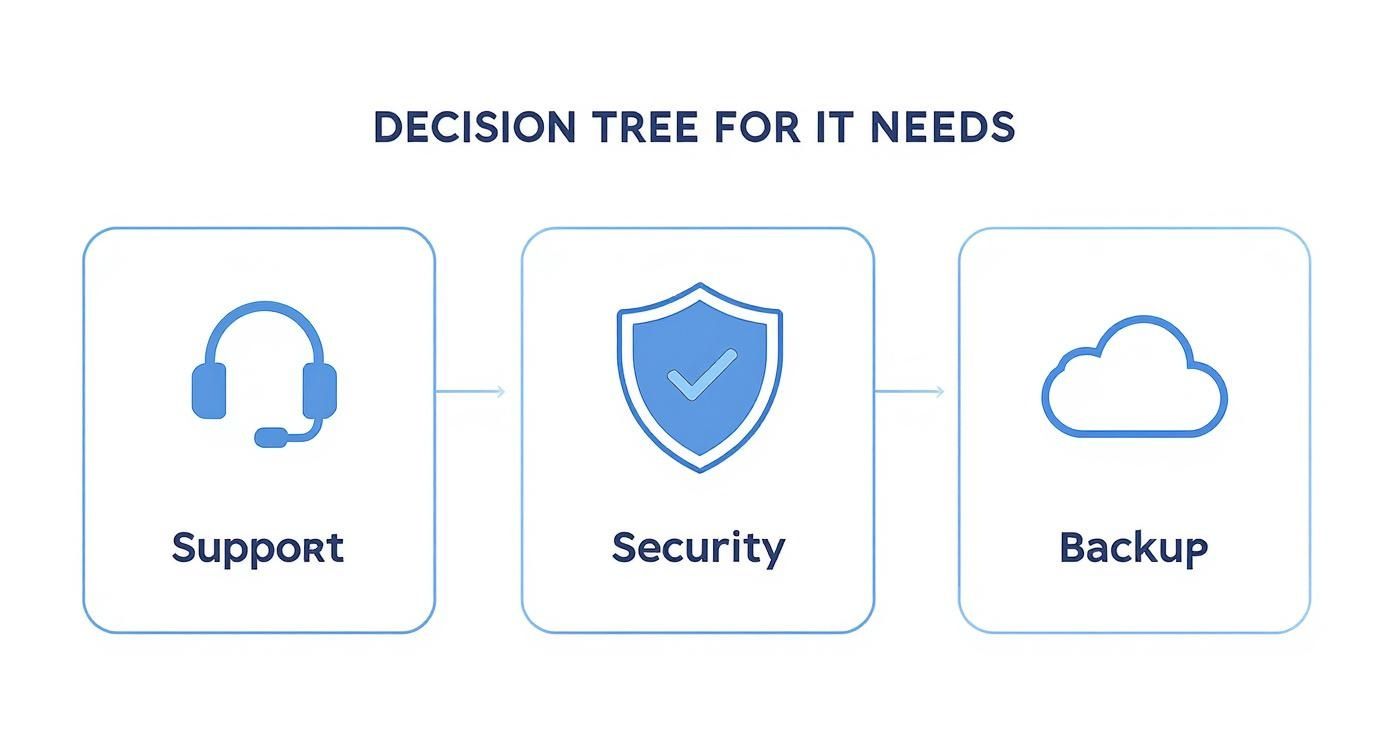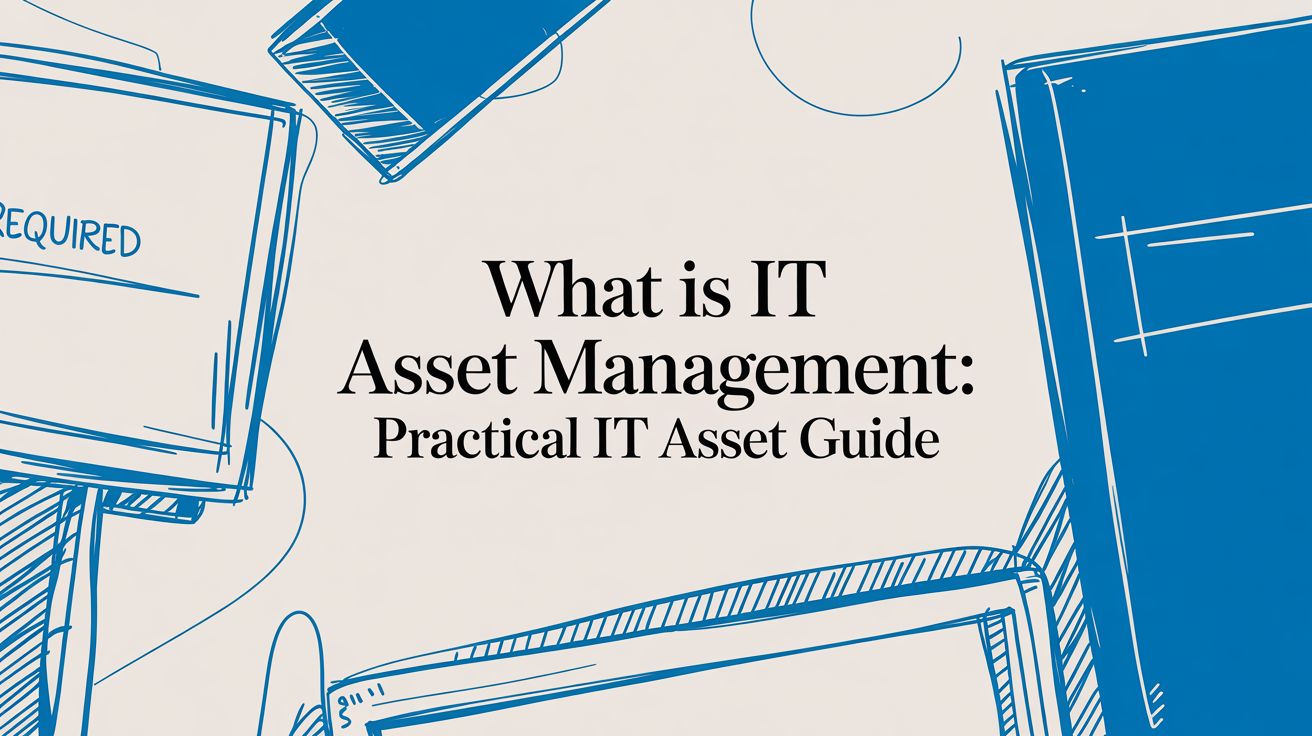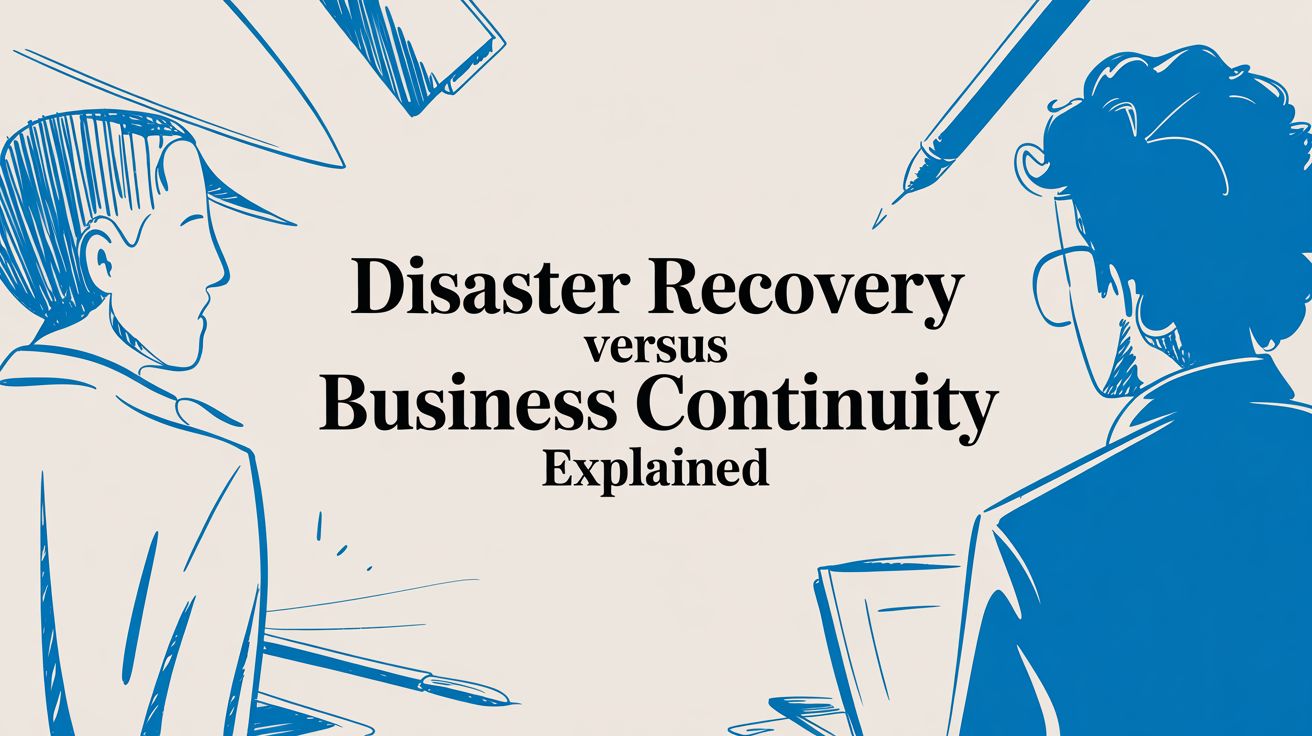Finding the Best Managed IT Services: A Guide for SMBs
The right managed IT service doesn't just fix things when they break; it stops them from breaking in the first place. This is the core difference between a reactive, "break-fix" approach and a proactive, strategic partnership. For small and mid-sized businesses, this shift is transformative. It’s about more than just keeping the lights on—it's about turning your technology into a genuine asset that fuels security, efficiency, and growth.
Why Proactive IT Is a Game Changer for Your Business

For a long time, the standard IT model for small businesses was like calling a plumber—you only picked up the phone when a pipe burst. This reactive, or "break-fix," model means you wait for a server to die, a network to crash, or a security breach to happen before you get help. It seems cheaper on the surface, but it’s a recipe for surprise bills, frustrating downtime, and lost productivity.
Think of it like driving a car. You wouldn't skip oil changes and tire rotations just to save a few dollars, right? You know that kind of neglect leads to a catastrophic breakdown on the highway at the worst possible time. Proactive IT management is that essential, routine maintenance for your business's technology, catching small issues before they become disasters.
Here’s a quick look at how these two philosophies stack up.
Break-Fix IT vs. Managed IT Services at a Glance
As you can see, the goals are completely different. One model waits for failure, while the other is designed to ensure success.
The Shift from Reactive to Strategic
This is where the best managed IT services truly shine. Instead of just being problem-solvers, a Managed Service Provider (MSP) becomes a partner dedicated to preventing problems. This means they are constantly monitoring your systems, applying security patches, and optimizing performance behind the scenes to keep your business running without a hitch.
This proactive approach transforms your IT budget from a series of unpredictable, painful invoices into a stable, fixed monthly cost. For businesses across Dallas and Memphis, that shift is huge. We dive deeper into this in our guide on the benefits of outsourced IT support.
Practical Example: A logistics company in Dallas was constantly wrestling with network outages. Their old IT guy only came out after a critical system failed, hitting them with emergency fees while their entire operation was at a standstill. After switching to an MSP, things changed dramatically:
- Immediate Stability: 24/7 monitoring quickly flagged a faulty piece of network hardware causing the random outages. It was replaced before it could fail completely, preventing further downtime.
- Budget Predictability: Their IT costs became a single, flat monthly fee. No more financial surprises.
- Improved Productivity: With downtime a thing of the past, their team could finally focus 100% on serving clients, not waiting for a fix.
A Growing Trend for a Reason
This move to managed services isn’t just a fad; it’s a fundamental business strategy. North America currently dominates the market, holding over 43% of the global share. Here in the U.S., the market is expected to hit a staggering $116.25 billion by 2030. That kind of growth sends a clear message: businesses are putting their trust in MSPs to manage their technology and guide their future.
A huge part of this proactive strategy is using technology to work smarter, not harder. By automating repetitive tasks, you can free up your team to focus on what really matters. When you prevent problems and optimize workflows, you’re not just fixing computers—you’re building a stronger, more resilient business.
The Building Blocks of a Strong Managed IT Partnership
Handing over your IT to a managed service provider (MSP) isn't just about outsourcing a task; it's about starting a partnership. And like any good partnership, it thrives on clarity and trust. The best MSPs don’t operate in a black box. They provide a specific set of services designed to make your business more secure, efficient, and resilient.
Think of these core services as the foundational building blocks for a stable and secure technology environment. Let's pull back the curtain on what these key components really do and why they matter for your business.
Proactive Monitoring and Maintenance
This is the absolute cornerstone of managed IT. Instead of the old "break-fix" model where you call for help only after something goes down, proactive monitoring flips the script. We use sophisticated tools to keep a 24/7 watch on your entire IT ecosystem—servers, laptops, network gear, you name it. It’s like having a security guard who never blinks, constantly looking for the earliest signs of trouble.
When a potential issue crops up, like a server's hard drive getting dangerously full or some weird network traffic starts flowing, our technicians get an instant, automated alert. This lets them jump in and solve the problem before it can ever cause downtime.
Practical Example: A Dallas accounting firm's server was flagged by our system for sky-high processor usage every night. Had it been ignored, it could have easily crashed their system right in the middle of tax season. Our team dug in and found a rogue backup process eating up all the resources. We fixed it quietly overnight, and the client never lost a second of productivity. A potential crisis was completely averted.
Responsive Helpdesk Support
Even with the best preventative care, things happen. Your team will still need help from time to time, and that’s where a truly responsive helpdesk becomes your lifeline. It's your direct connection to fast, knowledgeable support for all the day-to-day stuff—from password resets and software glitches to nagging connectivity issues.
A top-tier MSP offers more than just an email inbox. You should have multiple ways to get help (phone, chat, support tickets) and a clear promise on how fast they'll respond. This is critical to making sure your employees aren't just sitting around, unable to work.
"A great helpdesk doesn't just fix problems; it restores productivity. The speed and expertise of that support team have a direct impact on your company's bottom line."
Comprehensive Cybersecurity Defense
In today's world, cybersecurity isn't an optional add-on; it's a fundamental requirement. A real MSP partner delivers a layered security strategy to protect your business from every conceivable angle. This goes way beyond simple antivirus software. It’s a complete, multi-faceted defense system.
Key cybersecurity services should always include:
- Managed Firewalls: Your first line of defense, acting as a gatekeeper to filter out malicious traffic before it ever touches your network.
- Endpoint Detection and Response (EDR): Think of this as antivirus on steroids for your laptops and desktops. It actively hunts for and neutralizes advanced threats that older software would miss.
- Security Awareness Training: People are often the weakest link. This training teaches your team how to spot and avoid phishing scams and other clever social engineering tricks.
- Patch Management: Diligently applying security updates to all your software and systems is one of the most important (and overlooked) defenses. It closes the holes before hackers can wiggle through them.
Data Backup and Disaster Recovery
Ask yourself this: what would happen if a fire, flood, or ransomware attack wiped out all your company’s data tomorrow? A solid backup and disaster recovery (BDR) plan is what turns a potential catastrophe into a manageable inconvenience. And this is much more than just copying files to an external hard drive.
Modern BDR solutions take complete snapshots of your servers and critical systems. These images are stored both on-site for quick restores and securely in the cloud in a different geographic location. This ensures business continuity.
Practical Example: A Memphis medical clinic got hit with a nasty ransomware attack that encrypted their entire server. Because they had a robust BDR plan with us, paying the ransom was never even a consideration. We isolated the infected machine and restored their whole system from a clean backup taken just 15 minutes before the attack hit. Their staff was back to seeing patients that same afternoon with almost no data loss.
These are the non-negotiables: proactive monitoring, responsive support, ironclad security, and reliable recovery. They're what separate a basic IT vendor from a true strategic partner. Of course, tying these technical functions to your bigger business goals is just as important, which is where services like virtual CIO services that help Dallas businesses come in to guide smarter technology decisions.
How to Choose the Right Managed IT Service Provider
Picking a managed IT service provider isn't just about handing off your tech problems—it's a major business decision. The right partner acts like a strategic extension of your team, helping you grow. But the wrong one? That’s a recipe for frustrating downtime, gaping security holes, and costs that spiral out of control.
To find the right fit, you have to look past the sales pitches and shiny brochures. It comes down to digging into the core promises and operational details that truly define a provider's worth. Let's walk through what really matters when you're vetting potential partners for your Dallas or Memphis business.
Evaluate Response Times and Service Level Agreements
Let's be honest: one of the biggest reasons businesses look for a new IT company is because their current one is just too slow. When your team is stuck and work grinds to a halt, every single minute of waiting is money down the drain. This is where the Service Level Agreement (SLA) becomes your best friend.
An SLA isn't just another piece of paper; it's a hard-and-fast contract outlining the level of service you are guaranteed to receive. You should never accept vague promises like "we'll get to it as soon as we can."
- Get Specific: Ask them point-blank: What’s your guaranteed response time for a server crash versus a simple password reset? The answer matters.
- Define "Response": Does a "response" mean you get an automated email with a ticket number, or does it mean a qualified technician is actively looking at your problem?
- Ask About Resolution Goals: No one can promise a specific fix time, but a good provider has internal targets and can tell you their average time to resolve different types of issues.
Practical Example: The High Cost of Waiting
We once worked with a Dallas property management firm that was losing hours of productivity every week because their old IT provider was painfully slow. Simple help requests would sit unanswered for days. When they came to us, the first thing they asked about was our SLA. They needed a partner who respected their time, and our concrete promise of support in under three minutes gave them the confidence they needed.
This simple decision tree can help you visualize where your most immediate needs lie, whether it's day-to-day support, beefing up security, or making sure your data is safe.

While all three areas are critical, knowing your top priority helps sharpen your focus during the evaluation process.
Scrutinize Cybersecurity Expertise
In today's world, cybersecurity isn't an optional add-on; it has to be baked into everything an IT provider does. A company's approach to security is a massive indicator of its overall competence. You need a partner who brings a proactive, multi-layered defense strategy to the table—not just a basic antivirus subscription.
When you're trying to find the best managed IT services, ask them to walk you through their security stack:
- Advanced Threat Protection: Do they use modern tools like Endpoint Detection and Response (EDR) or Managed Detection and Response (MDR)? These solutions actively hunt for threats instead of just reacting to known viruses.
- Security Awareness Training: Technology is only half the battle. How do they help train your employees to spot phishing scams and other tricks? Your team should be your first line of defense, not your weakest link.
- Compliance Experience: If you operate in a regulated field like healthcare (HIPAA) or finance, you need a provider who understands those rules inside and out. Ask for proof of their experience.
Look for a Proactive Strategic Approach
A good MSP fixes things when they break. A great MSP keeps them from breaking in the first place and helps you plan for the future. Their role should be less like a mechanic and more like a trusted technology advisor.
This proactive mindset is what separates a simple vendor from a true partner. To learn more about what a provider should be doing behind the scenes, you can read our guide on what managed service providers do.
As you talk to potential providers, ask how they turn this proactive philosophy into action:
- Do they schedule regular business reviews to align technology with your goals?
- Will they build a technology roadmap to help you budget for future upgrades?
- How do they keep you informed about new tech or emerging threats that could affect your business?
Before making a final decision, having a structured list of questions is invaluable. This table covers the essential areas you need to probe to ensure you find a reliable and effective IT partner.
Key Questions to Ask a Potential IT Provider
Using these questions as a guide will help you cut through the noise and evaluate providers on the factors that truly impact your business's success and security.
Finally, don't forget to ask for proof. Request client testimonials, case studies, and references, especially from businesses in your industry. Seeing real-world success is the best confirmation that a provider can truly deliver on their promises.
Finding the Right Managed Services Model for You

Deciding to work with a managed service provider is the first big step, but it's not the last. "Managed IT" isn't a one-size-fits-all product; it's a flexible approach with several different service models built to match a business's unique needs.
Getting a handle on these models is crucial for finding a partner that truly aligns with your goals, your budget, and the resources you already have in place. The best managed IT services for your company will feel like a natural extension of your own team, whether that means they take over everything or just lend a hand where you need it most.
Let's break down the most common models so you can see which one makes the most sense for you.
The Fully Managed Model
This is the classic, all-in-one approach. When you go with a fully managed model, you are essentially outsourcing your entire IT department to the provider. They take complete ownership of everything from day-to-day helpdesk support and 24/7 monitoring to long-term strategic planning and cybersecurity.
This model is a perfect fit for small and mid-sized businesses that don't have an in-house IT person or team. It gives you immediate access to a full suite of enterprise-grade tools and a deep bench of experts for a predictable monthly fee—which is almost always more cost-effective than hiring a full-time IT staff.
Practical Example: A small Dallas law firm without a dedicated IT employee partners with an MSP for a fully managed plan. The provider handles everything from network security and data backups to providing instant remote support when a paralegal has a software glitch. This frees up the firm's partners to focus on their clients, not on technology headaches.
The Co-Managed IT Model
What if you already have an IT person or even a small team? That's where the co-managed model, often called "Co-MITs," comes in. This is a true strategic partnership where an MSP works right alongside your internal staff to fill gaps, bring in specialized expertise, or simply handle the routine, time-consuming tasks.
This kind of collaboration liberates your internal team from the daily grind of helpdesk tickets and software updates. It lets them concentrate on high-value, business-specific projects. Meanwhile, the MSP can bring advanced security tools, 24/7 monitoring, and specialized knowledge that would be too expensive or difficult for your team to maintain on its own.
Practical Example: A mid-sized Memphis manufacturing company has a two-person IT team that knows their proprietary production software inside and out. They use a co-managed model where the MSP handles all cybersecurity monitoring, endpoint protection, and data backups. This empowers their internal team to focus on optimizing the factory floor systems, all while knowing their security is in expert hands.
A La Carte Services
Sometimes, a business has most of its IT covered but just needs help in one or two specific areas. A la carte services let you pick and choose the exact support you need without committing to a comprehensive plan.
Common a la carte options include things like:
- Data Backup and Disaster Recovery
- Cybersecurity monitoring (like EDR/MDR)
- Helpdesk support
This model offers maximum flexibility and is a great option for startups or businesses with very specific compliance needs on a tight budget. You can solve your most critical IT pain point immediately while planning for more support down the road.
Practical Example: A Dallas startup has a limited budget but needs to meet strict data protection standards for an upcoming client contract. They opt for an a la carte Backup and Disaster Recovery service from an MSP. This ensures their data is secure and recoverable, satisfying the client's requirements without the cost of a full managed services plan.
The immense value of these flexible models is a key reason the global managed IT services market is booming. Estimated at approximately $441.1 billion in 2025, the market is projected to reach an incredible $1,314.9 billion by 2035. This growth shows just how many businesses are embracing managed services for scalable, expert-led solutions. You can learn more about these market trends and their drivers.
Of course, a critical part of this decision is figuring out which infrastructure is right for you in the first place, and you can explore that in our cloud vs on-premise comparison guide.
The Real Business Impact of Strategic IT Management

So far, we've walked through the different services and models that make up a modern IT partnership. But let's be honest—at the end of the day, business leaders in Dallas and Memphis really only care about one thing: results. The true value of the best managed IT services isn't buried in technical jargon; it’s measured in tangible outcomes like lower costs, higher productivity, and a much stronger security posture.
This is where IT stops being just another expense and starts becoming a powerful engine for growth. It’s all about translating proactive monitoring, efficient remote support, and robust security into a direct, positive impact on your bottom line. When your tech just works, your entire business simply runs better.
From Unpredictable Costs to Measurable ROI
One of the first things businesses notice when they switch to a managed services model is the move away from chaotic, unpredictable IT bills to a fixed, predictable monthly investment. The old break-fix approach is a financial rollercoaster. One minute everything is fine, and the next, a server failure lands a five-figure emergency repair bill on your desk without any warning.
Proactive IT management completely flattens that curve. By catching and fixing potential issues before they can cause downtime, an MSP prevents those expensive emergency calls from ever happening in the first place. That stability means you can finally budget with confidence and put your capital toward growth, not last-minute fires.
This shift is a huge reason the managed services market is growing so fast—consistently seeing annual growth rates between 11% and 14%. As global spending on managed services is projected to fly past the $500 billion mark, it’s clear that businesses are seeing a powerful return on investment, largely driven by the need for better cybersecurity and cloud adoption.
Boosting Productivity and Operational Efficiency
Downtime doesn't just halt work; it kills momentum and drives your team crazy. Every minute an employee spends wrestling with a tech problem is a minute they aren't helping clients or pushing projects forward. Strategic IT management is fantastic for improving productivity through optimized operational workflows because it gives that time back.
Efficient remote support is a huge part of this. When an employee runs into an issue, they can get expert help in minutes, not hours or days. This rapid response gets them back on track fast, keeping workflows smooth and disruptions to a minimum.
But a great MSP goes deeper, optimizing your entire technology stack for better performance. This often includes:
- Network Optimization: Making sure connectivity is fast and reliable so your cloud apps and data are always instantly accessible.
- Hardware Lifecycle Management: Replacing old, slow equipment before it starts to fail and drag your team down.
- Cloud Solutions: Implementing powerful tools like Microsoft 365 to make collaboration seamless and allow your team to work securely from anywhere.
A Compelling Client Story of Transformation
Let me give you a practical example. We worked with a DFW-based property management company that was constantly hamstrung by IT issues. Their small internal team was completely overwhelmed. Frequent network outages meant leasing agents couldn't access tenant information, which led to frustrating delays for everyone.
After they partnered with PWR Technologies, the change was incredible.
Our proactive monitoring tools immediately flagged a failing network switch as the root cause of the constant outages. We had it replaced overnight, eliminating a problem that had plagued them for months. With a stable network and our responsive helpdesk on standby, their team's productivity just soared.
Within six months, the client told us they’d seen a 40% reduction in IT-related support tickets and a massive drop in employee downtime. This freed up their team to process maintenance requests faster and close leases more efficiently, which directly fueled a measurable bump in revenue.
Their investment in managed services paid for itself not just by avoiding costly downtime, but by creating real, tangible business growth. That's the true impact of turning your IT into a strategic asset.
Common Questions About Managed IT Services
Even after seeing all the benefits on paper, it's completely normal to have a few lingering questions before you sign on with a managed IT services partner. This is a big decision for your business, and you absolutely should get clear, direct answers. Let's walk through some of the most common questions we hear from business leaders right here in Dallas and Memphis.
Getting a handle on these points helps clear away the jargon and gives you the confidence to find the right partner for your company.
Is My Business Too Small for Managed IT Services?
We hear this one all the time, and the answer is a hard no. In fact, you could argue that smaller businesses often get the most value out of partnering with a Managed Service Provider (MSP). Think about it: without an MSP, your only other option is shouldering the massive expense of hiring, training, and keeping a full-time IT expert on staff.
An MSP completely changes the game. It gives you access to the same high-end tools and deep expertise that large corporations use, but for a predictable monthly fee. It’s a model that scales right alongside your business, delivering rock-solid cybersecurity, reliable backups, and expert support from the very beginning. You get to focus on what you do best—running your business—instead of worrying about IT.
How Much Do Managed IT Services Typically Cost?
While the exact price tag can vary, one thing is certain: it's almost always more predictable than the old "break-fix" way of doing things. The final cost usually comes down to a few key factors, like the number of people and devices on your team, how complex your current setup is, and which specific services you need.
Most providers use a flat-fee subscription, typically billed per user each month. This structure is designed to make your IT budget stable and predictable, getting rid of those shocking invoices that pop up after an emergency. The best providers are transparent about their pricing. If you want to get into the nitty-gritty, our guide on understanding managed IT services costs breaks it all down.
Ultimately, this proactive approach is far more cost-effective because it prevents the expensive downtime and data loss that can bring a business to its knees.
What Is the Difference Between Co-Managed and Fully Managed IT?
Nailing down this distinction is crucial to finding the right fit for your company. They are two very different approaches designed for different needs.
- Fully Managed IT: This is the all-in-one solution. Your MSP essentially becomes your IT department, handling everything from daily helpdesk tickets to long-term strategic planning. It’s the perfect choice for businesses that don’t have any internal IT staff.
- Co-Managed IT: Think of this as a strategic partnership. The MSP works directly with your existing IT team to fill gaps and add specialized skills. For example, your MSP might handle 24/7 network monitoring and advanced cybersecurity, freeing up your in-house staff to focus on projects that directly impact your business goals.
The right model really just depends on your current team and where you want to go.
How Long Does It Take to Onboard with a New IT Provider?
A smooth, painless transition is everything, and any professional MSP will have a well-defined onboarding process to make sure there's as little disruption as possible. The timeline can be anywhere from a few weeks to a couple of months, mostly depending on how complex your current IT systems are.
A well-executed onboarding process is a sign of an organized and competent provider. It should be a seamless experience that sets the foundation for a strong, long-term partnership.
The process is usually broken down into a few key stages:
- Initial Assessment: A deep dive to understand your current infrastructure, systems, and frustrations.
- Agent Deployment: Installing monitoring and security software on all your devices to get that proactive oversight in place.
- Network Documentation: Creating a detailed map of your entire environment so support is fast and efficient down the road.
- Team Integration: Introducing your staff to the new support process and making sure everyone knows exactly how to get help when they need it.
A top-tier provider will manage this whole process for you, keeping you in the loop at every step so your day-to-day operations can continue without a hitch.
Ready to stop worrying about IT and start focusing on your business? The team at PWR Technologies LLC provides proactive managed IT services that Dallas and Memphis businesses trust. We deliver real human support in under three minutes, prevent 99% of problems, and offer a no-risk 90-day guarantee. https://www.pwrtechnologies.com




